Want to get familiar with one of the biggest, most spectacular Milk Snake subspecies? Then come and check out my Honduran Milk Snake Care Sheet.
Last updated on February 1st, 2023 at 09:43 am
Honduran Milk Snakes may be larger than most other Lampropeltis species and subspecies, but their care is just as easy. Asides from a larger enclosure, most of their care requirements are extremely simple, making them hardy, long-lived captives. Give them fresh water, a temperature gradient and hiding places and you really can’t go wrong.
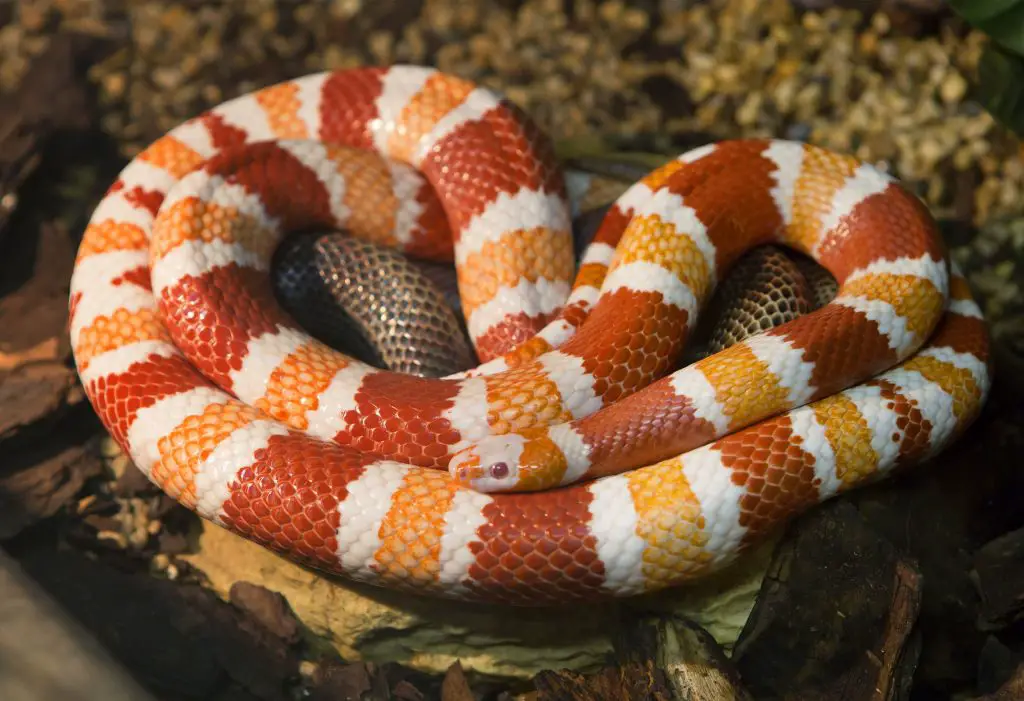
Description
Being a typical Coral Snake mimic, the Honduran Milk Snake (Lampropeltis triangulum hondurensis) has a striking pattern of red bands. Each of these borders two black bands with a yellow to orange band in the middle.
When compared to more northerly subspecies, like the Mexican Milk Snake (L. t. annulata), the red bands on a Honduran Milk Snake are wider and darker. The yellow/orange bands are also less colourful. In many specimens they are even faded white.
As for the black bands, these are very dark and distinct, making the wholes snake’s appearance darker than most of its relatives. On the head, there is a broad orange band that covers the posterior portion on both the top and jaws.
This combination gives an appearance which is remarkably like central American coral snakes in the genus Micrurus.
In most Honduran Milk Snakes, the colouration gets much darker with age.
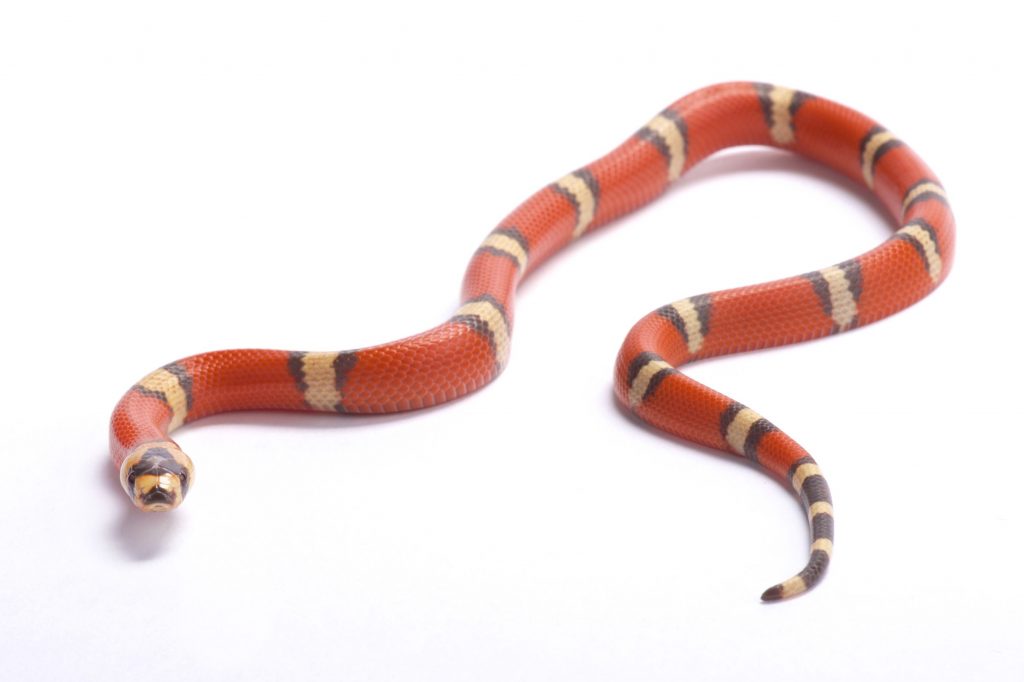
How long do Honduran Milk Snakes get?
Honduran Milk Snakes are much bigger and chunkier than most of their relatives. If you’re used to American Milk Snakes, you’ll be quite surprised when you get your first Honduran!
As hatchlings, these snakes are at least 8 inches (20cm) in length and 20+ grams in weight. This is more comparable in size to most Rat Snake (Pantherophis) babies than other Milk Snakes.
When fully grown, they regularly get from 4 to 5ft long (1.2 – 1.5m), but I would say 4ft (1.2M) is average. There are several reports of them reaching over 6ft (1.8m) in length but this is very rare. Remember, when it comes to big snake stories, don’t believe it until you see it!
If you buy a Honduran Milk Snake, plan on housing an animal that will almost certainly be between 4 and 5ft (1.2 – 1.5m) long when fully grown. To reach this size it generally takes 24 to 36 months.
Honduran Milk Snake Morphs
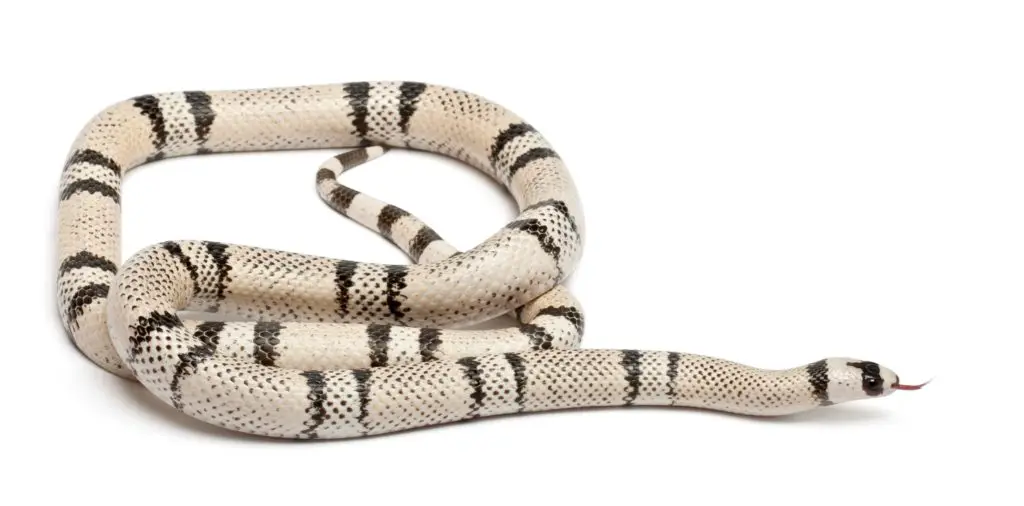
Honduran Milk Snakes come in a handful of highly sought-after and unusual morphs. In fact, it is the morphs that get the attention of many hobbyists in the first place.
Most of these morphs are, in my opinion, much more attractive than the wild type. I’m not the only one who thinks so either, as they are now becoming widely available. Not surprisingly, the easiest place to find them is on Morphmarket.
To date, the most common are hypo (reduced melanin), albino, and my personal favourite: Tangerine. The Tangerine morph has incredibly attractive patterning where the yellow bands are – you guessed it – tangerine instead.
When you combine these morphs, you can create even more stunning, colourful snakes. When combining Hypo and Tangerine, for example, you get amazing animals that are two shades of intense orange bordering black bands.
Other popular morphs include aberrant (unusual markings), anerythristic (lacking red/orange pigment) and vanishing Pattern which greatly reduces the black bands.
If you’d like to learn more, check out my post on the Top 5 Honduran Milk Snake Morphs.
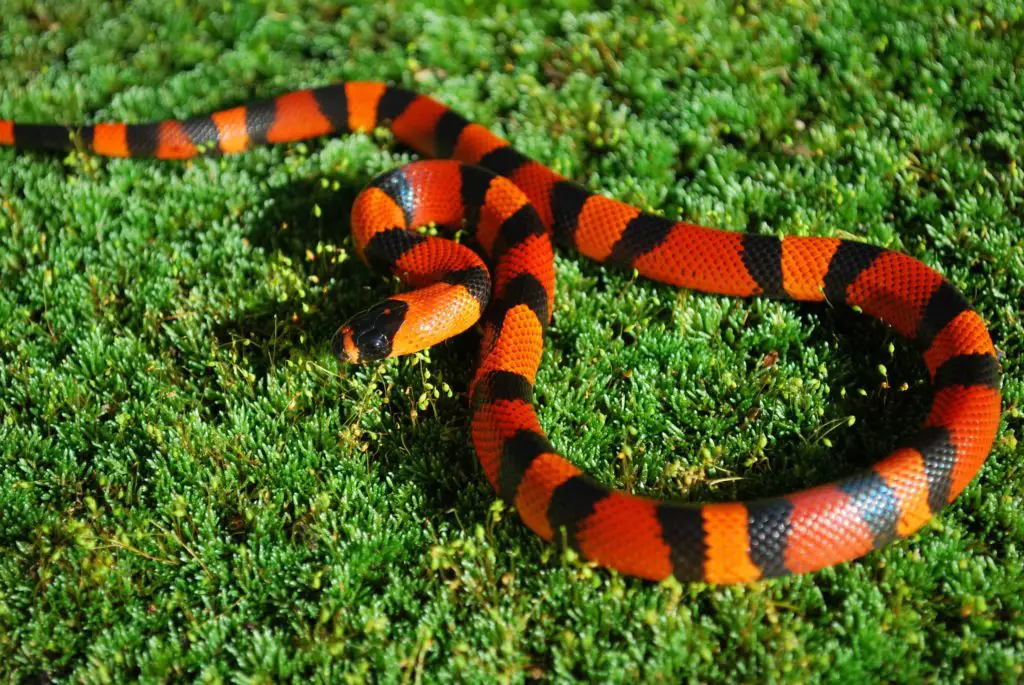
Did you know?
The Milk Snake’s use of its colouration to frighten predators is often described as aposematism – but this isn’t entirely accurate.
Aposematism is the phenomenon where venomous or poisonous creatures use bright colours to warn predators how dangerous they are. This is what Coral Snakes do and is what sensory ecologists call “honest” signalling (they really are dangerous!)
Conversely, what we see with Milk Snakes is called Batesian Mimicry. This is a phenomenon where a harmless animal uses a venomous animal as a model and copies its markings. The aim of this is to fool predators into thinking it is the same. Sensory ecologists call this “dishonest” signalling.
The model animal for the Honduran Milk Snake is one of the members of the coral snake genus Micrurus, though it’s hard to know which one for sure.
Are Honduran Milk Snakes good pets?
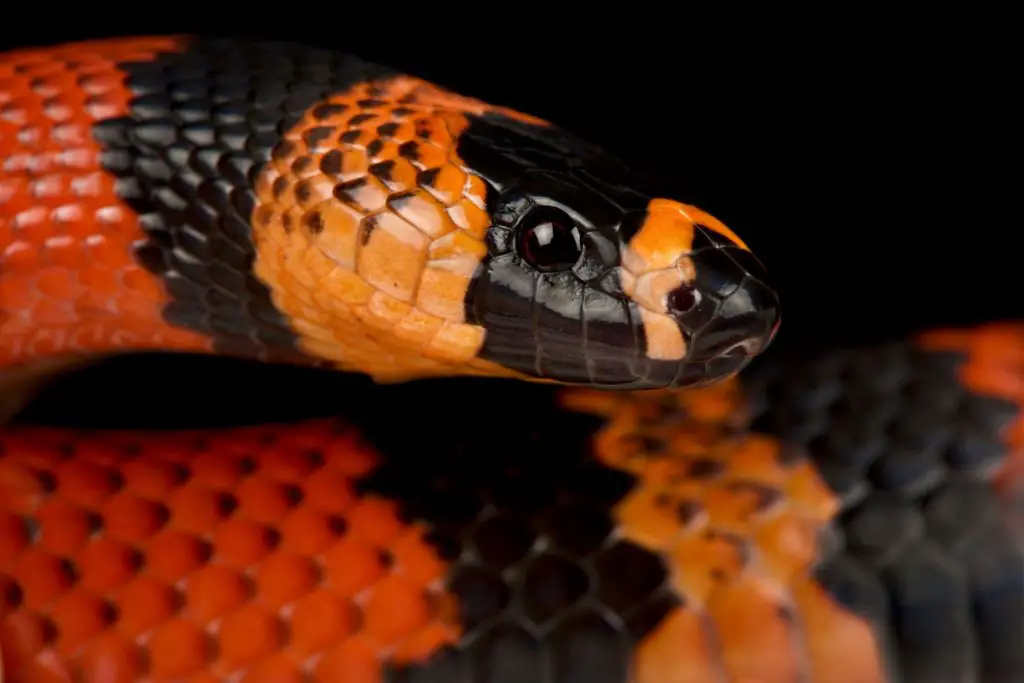
Honduran Milk Snakes are great pets. They’re hardy, beautiful animals that tend to be good feeders too.
They’re also bigger and more docile than many milk snakes. For me, this makes them more enjoyable to handle and more impressive to look at.
Being less delicate than many tropical species, they can easily live to over 12 years old and possibly 20 in captivity. It is just a case of getting their very simply husbandry requirements right – which we’ll discuss in the next section.
All-in-all, the only drawback with this subspecies is that it is shy and likes to spend most of its time hiding. They simply don’t make good display animals.
Honduran Milk Snake Enclosure
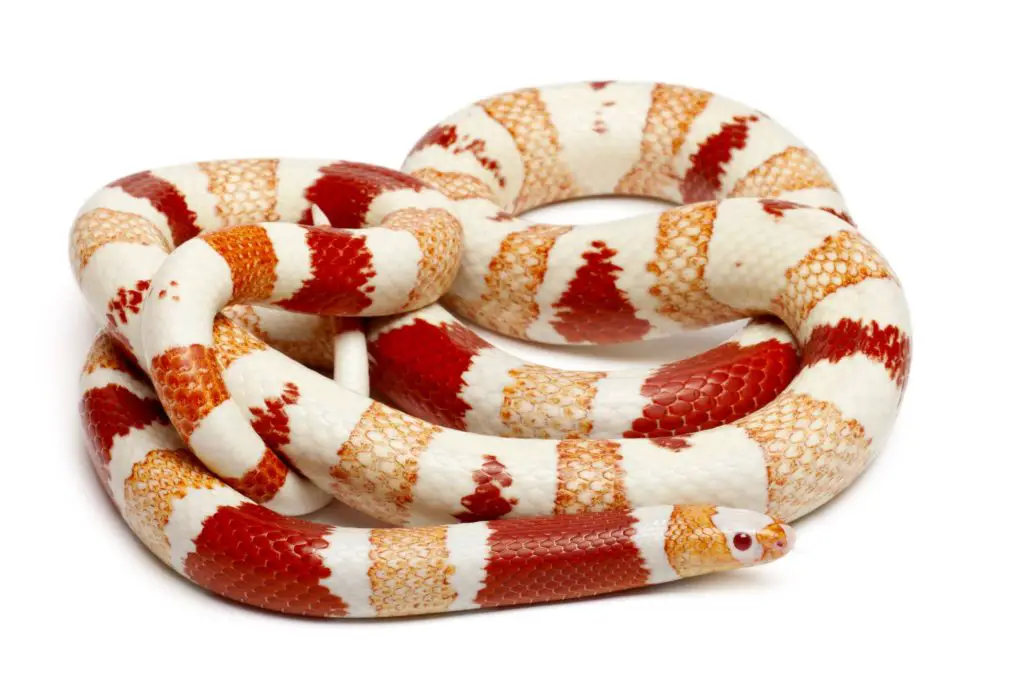
Unlike some other large colubrids which are active and need a lot of space, Honduran Milk Snakes are prone to stress if kept in enclosures that are too big or lack cover.
It’s best to keep hatchlings in plastic tubs, or flat faunariums that are roughly 12-16 inches (30-40cm) long for the first few months of their lives. The advantage of these being that they hold humidity well and are cheap to replace when upgrading in size.
Adults will eventually need a 36-inch-long enclosure, that can be a plastic tub, tank or vivarium. It doesn’t matter which you choose so long as it keeps in the warmth and still has good ventilation.
As with any Lampropeltis species, they can be cannibalistic so must always be keep alone unless breeding.
Heating
Temperatures should be slightly warmer in the hot spot for this snake than for many tropical species. For some reason, many resources used to recommend cool temperatures for Hondurans which would have been more appropriate for deep rainforest reptiles.
Nonetheless, evidence suggests the Honduran Milk Snake does in fact inhabit many lowland areas that are not rainforests and therefore get much hotter.
As in most reptile species, there needs to be a thermal gradient from one side of the enclosure to the other so that your snake can choose how warm it wants to be.
My recommendation is a warm spot of 88-90F (31-32C), which is best achieved with either a heat mat placed under a hide or ceramic heat emitter place above one. Remember that you must always use a protective guard with heat emitters to prevent burns.
If using a heat mat, make sure it covers roughly 40% of the underside of the enclosure, this will create a large enough warm area, but still leave enough room for a thermal gradient.
Whichever heat source you use, make sure that you choose an appropriate thermostat to avoid burning the animal.
On the cool side, the temperature should be around 77-80F (25-26C).
At night, it’s a good idea to let the cool end drop by a couple of degrees, and this will happen on its own if your house is naturally a bit cooler at night. If not, many thermostats now come with a night-time setting.
For mats, on/off thermostats work well, as do pulse proportional thermostats. For heat emitters you must always use a pulse proportional.
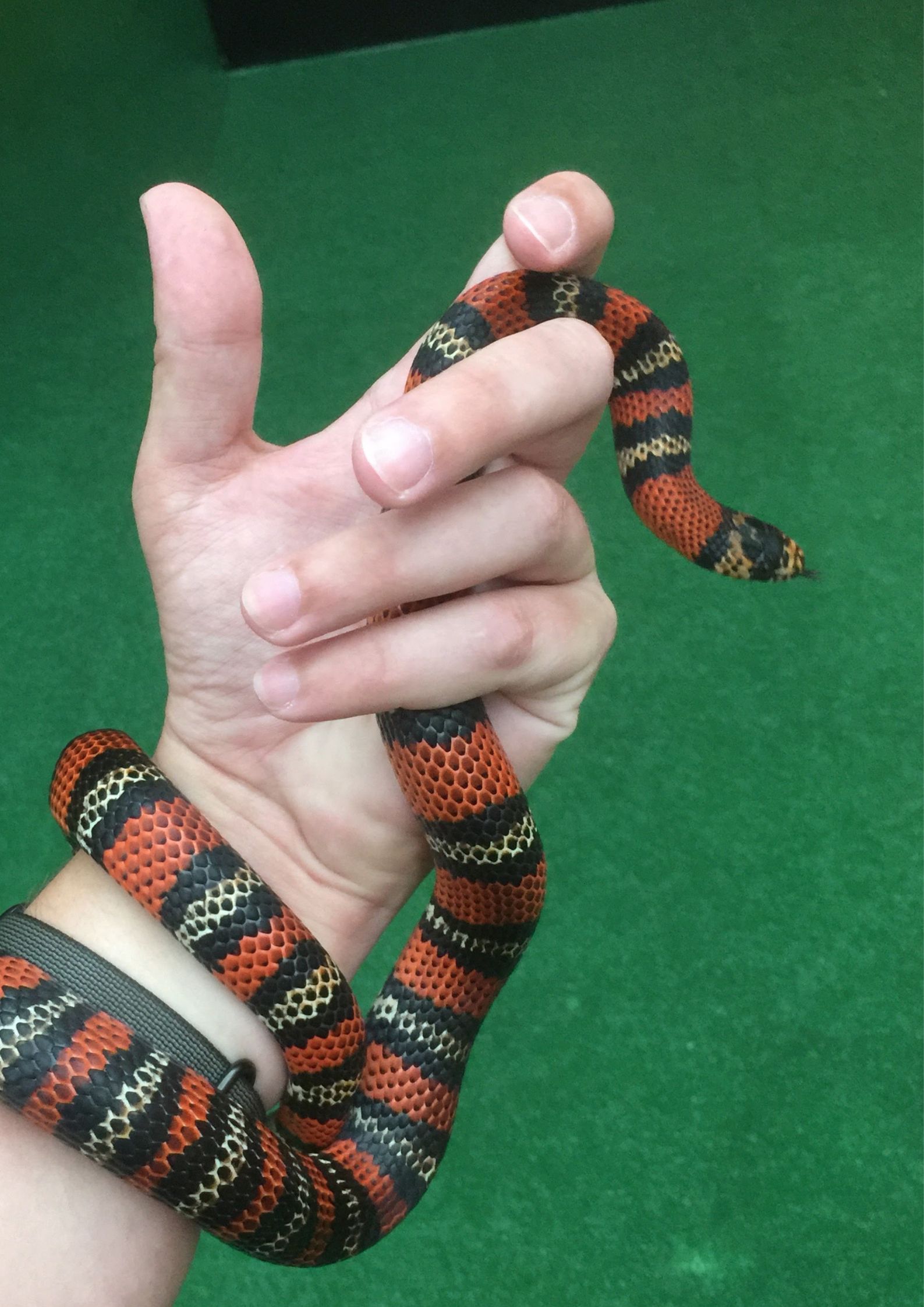
Regulating temperature
If using a heat mat (which would be my choice) place the thermostat probe on top of the heat mat, under the outside of the warm end of the enclosure. If using a heat emitter, place the probe in mid-air on the warm end, but not directly under the heat source, and just a few inches above the floor.
To measure temperatures with a heat mat, the easiest way is to put a digital thermometer probe under the substrate underneath your pets hiding place on the warm side.
To measure temperatures with a heat emitter, I recommend using a thermometer gun (these are a lot cheaper than they used to be!). Simply point it at the surface of the area you want to measure. You can also use a digital thermometer under the warm hide for good measure.
Light
As with most nocturnal snakes, Honduran milk snakes do not require UVB light for the synthesis of vitamin D and calcium absorption.
What they do need is to know when its day or night – ambient light should be provided on a consistent 12hr cycle, year-round.
This can be just the light in the room or tube lighting fitted above the tub.
If you wish to make a bioactive vivarium, you can provide UVB lighting, but given how shy these snakes are you won’t be observing them much anyway!
Water and humidity
These snakes come from areas that experience heavy downpours and will appreciate a water bowl big enough to soak in, especially when getting ready to shed their skin.
Make sure the water is clean and replaced every few days (I aim for twice a week with all my animals).
As far as humidity goes keep it in the 50-60% range for optimum shedding.
If the animal does have trouble shedding, get into the habitat of spraying its enclosure or adding damp sphagnum moss to its hide around shedding time.
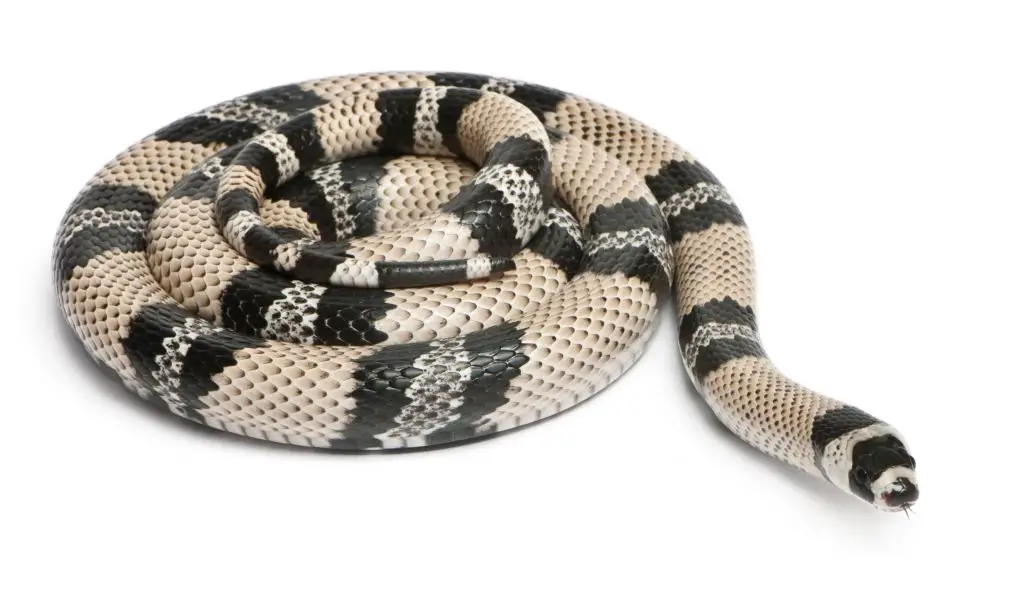
What do Milk Snakes need in their tank?
Honduran milks snakes enjoy rooting around and even burrowing at times, so it’s best to give them a substrate that facilitates this. In my opinion, cypress mulch is particularly good as it naturally holds humidity well. Other choices include aspen, Lignocel (mulched paper) or orchid bark.
Notwithstanding, good old-fashioned newspaper or strong paper towels can work well for young animals that pee more often.
Along with an appropriate substrate, Honduran Milk Snakes need nice, sturdy hiding places to make them feel safe. Place one on the warm end and another on the cool end. I recommend the exo terra caves, but anything with some weight to it can work well, from logs to flowerpots.
Another measure that will help them feel secure is adding branches and fake plants to further clutter up the enclosure.
Despite how well-marketed they are, I do not recommend bioactive enclosures because of how unhygienic they are for animals of this size. You can read more about this in my Ball Python Care Sheet.
Let’s look at a nice example of a Milk Snake enclosure. As you can see, it doesn’t have to be complicated…
Hygiene
As with most snakes, ventilation is important for maintaining low mould and bacteria growth. If using a plastic tub enclosure, make sure it has enough vents or make holes in it. Most vivariums come with vents built in, but you can buy them online if not.
For general hygiene, remove faeces or soiled patches of substrate immediately, and completely change the substrate every few weeks.
When you change the substrate, clean all surfaces of the enclosure with veterinary disinfectant or soapy water. Personally, I don’t recommend using bleach as it can soak into wood or ornaments.
What do Honduran Milk snakes eat?
In the wild Honduran Milk Snakes will eat rodents, lizards, and other snakes. To be honest they aren’t too picky!
In captivity, hatchlings can be fed pinky mice, and average sized adults do well on adult mice.
For adults that get over 4 ft in length, moving them onto rats can be necessary to keep them satiated for longer, and for convenience.
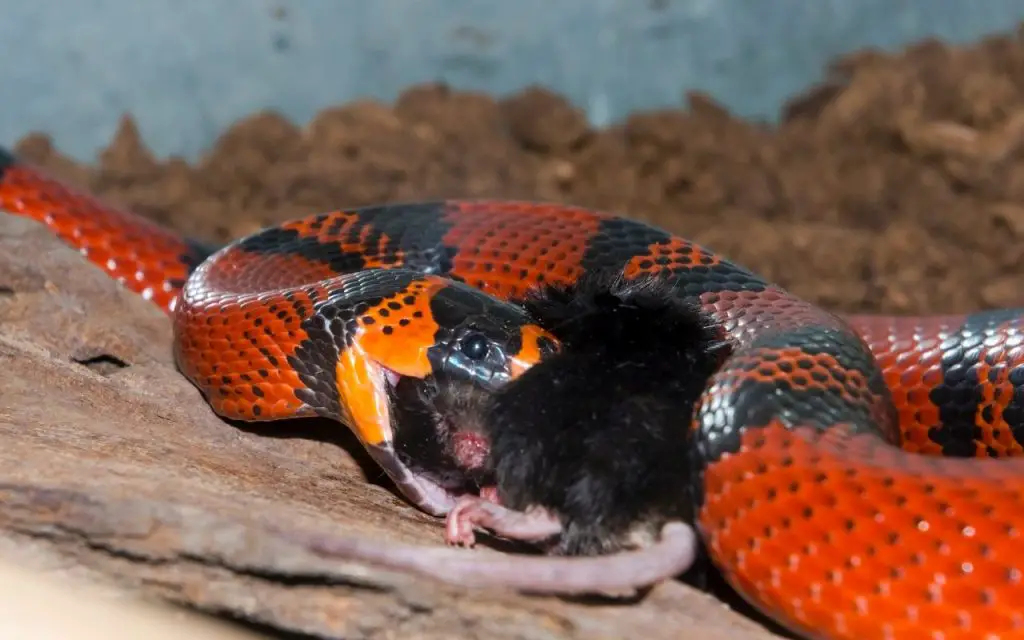
How much do you feed a Honduran Milk Snake?
Always feed a prey item or two that is just a little thicker than your milk snake’s body. This species doesn’t like big meals that are a battle to swallow (unlike some pythons, for example).
For hatchlings feed them a pinky mouse or two every 5 days until 3 months old. From 3 months onwards feed larger prey but only once every 7 days.
Average adults can be fed two adult mice every 7-10 days or 1 small rat every 7-10 days.
For animals over 10 years in age, the metabolism can slow down quite a lot; at this point I recommend feeding every 10-14 days to avoid obesity.
Handling
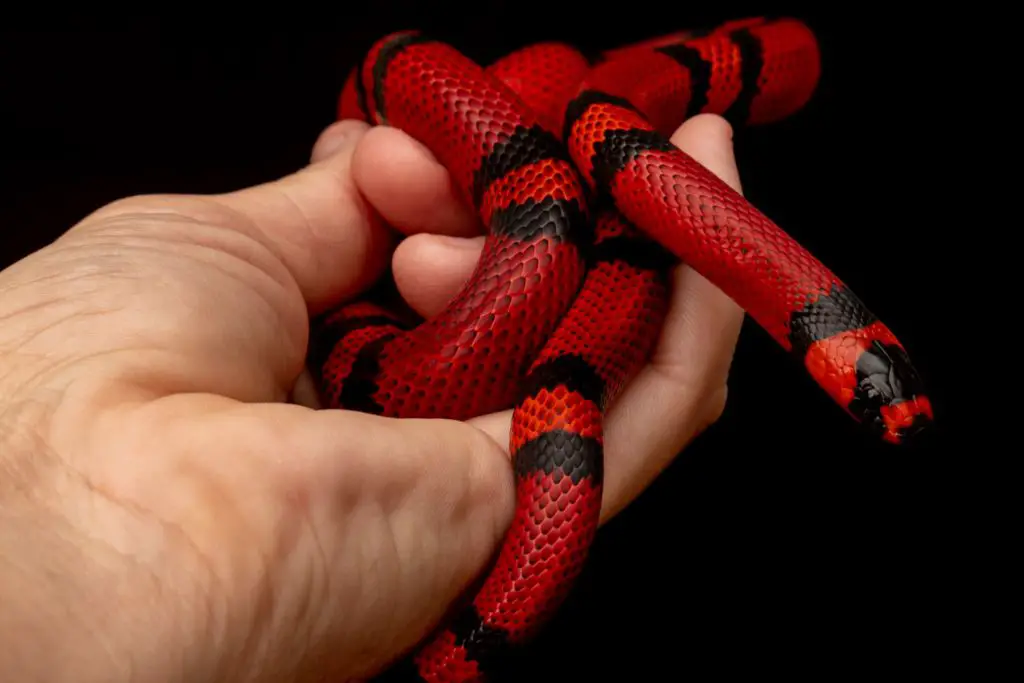
Hatchling Milk Snakes can be quite annoying to handle! They may rattle their tail and strike before being picked up, then squirm around and poop on you during.
That said, with Honduran Milk Snakes this behaviour vanishes after a couple of weeks of gentle handling every few days. As with Bull Snakes, don’t try to restrain them, just let them move through your fingers and explore for a while.
When past the hatchling stage, these snakes generally become incredibly docile and relaxed.
Honduran Milk Snake Care Summary
| Temperature: | 88-90F (31-32C) on the warm end and 77-80F (25-26C) on the cool end, drop a couple of degrees at night |
| Humidity: | 50-60%, monitor more closely during shedding |
| Favourite food: | Mice and rats |
| Enclosure size: | 12-16 inches (30-40cm) long for hatchlings, increasing to 36 inches (90cm) for adults. |
| Activity rythm: | Nocturnal |
| Lighting needs: | UVB unecessary, but ambient lighting beneficial |
How do Honduran Milk Snakes Compare to other pet snakes? (my verdict)
Honduran Milk Snakes offer something that most of the Milk Snake subspecies don’t: they’re big and chunky. Myself, I prefer snakes in the 3-6ft (90-150cm) range, and these guys fit that perfectly.
They also turn into very docile adults and have minimal husbandry requirements. With proper care, they can in fact turn into hardy, long-lived pets, much like Corn Snakes.
Add to this the fact that some Honduran morphs display exceptionally intense orange hues, and you have an animal that really is unique.
My verdict is: if you love tricolour Lampropeltis species and their morphs but prefer larger snakes – then this subspecies is for you!

Key points to remember about Honduran Milk Snake care
- Being from Central America, Honduran Milksnakes requires slightly higher humidity levels than some of their more northerly relatives like the Mexican Milk Snake, for example.
- Whilst young snakes can be fed often, adult Milk Snakes are prone to obesity: especially when over ten years of age. Always slow down food intake with age. Though some adults do well on large mice, some females will grow into large snakes that require rats instead. This website does not recommend feeding live rodents.
- When it comes to desiging an enclosure, be aware that a baby milk snake may do best in a plastic container to start with. This is because they can feel lost and overwhelmed in large enclosures.
